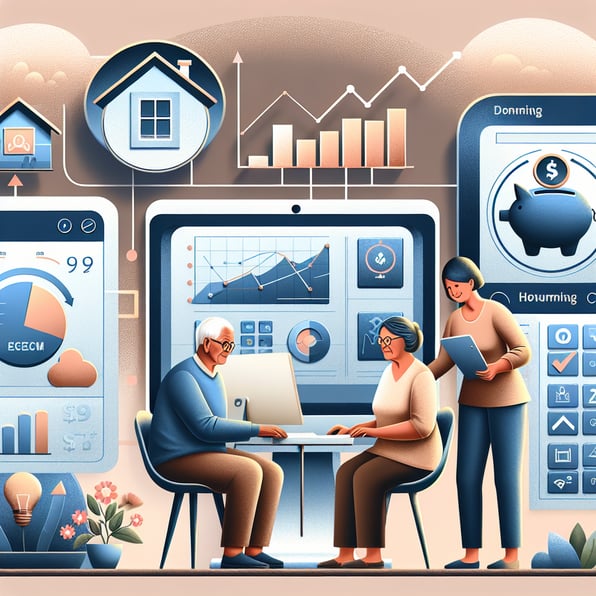Understanding the Impact of Inflation on Senior Living Expenses

As a consumer, you’ve likely noticed that the cost of most items has gone up noticeably in the last couple of years. As a senior living operator, you’ve probably seen the same trends reflected in the long-term care space. The cost of goods goes up, which means your overhead goes up, which leads to increased costs for senior living residents. In fact, nursing home care rates are currently outpacing the rate of inflation in the U.S., meaning prices are higher than ever — for both senior living communities and their residents.
This all comes on the heels of news that 70.6 million Americans, mainly seniors, are expecting to receive a lower cost-of-living adjustment in Social Security benefits for 2025.
Times are tough everywhere, but they’re particularly challenging for seniors. As a senior living operator, it’s critical to understand what this means for seniors living on fixed incomes and what the rate of inflation and rising prices will mean for your community. Here, we’ll take a deep dive into inflation and the way it impacts older Americans living in senior housing spaces like yours; then, we’ll show you what you can do to minimize price increases and prioritize your residents’ well-being.
What Is Inflation and How Does it Impact Older Adults?
Think of inflation as a balloon. As prices increase, the balloon expands and grows bigger. Now, instead of money, think of the cost of the balloon in terms of the space it takes up as it inflates. An uninflated balloon takes very little space, which means you can have more of them. But as the balloon gets bigger and bigger, each one takes more space, leaving you with no room and no means to get more balloons.
In the U.S., we’ve faced unprecedented inflation in the post-COVID era. Inflation is measured by the U.S. Bureau of Labor Statistics and other government agencies using several different indexes, which include:
- Consumer Price Index (CPI): The CPI uses household surveys to track the prices of commonly purchased goods and services by the average consumer. These items are grouped into a metaphorical “basket,” and changes in the cost of this basket over time are used to calculate inflation rates.
- Personal Consumption Expenditures (PCE) Price Index: The PCE monitors inflation by tracking the prices of goods and services that households consume, including adjustments for changing spending habits and substitutions consumers make.
- Gross Domestic Product (GDP) Deflator: This global index measures inflation by comparing the current prices of all goods and services produced in an economy to prices from a base year, accounting for changes in overall economic output.
- International Price Program (IPP): The IPP tracks price changes for imported and exported goods, providing insight into inflation trends in global trade.
- Employment Cost Index (ECI): The ECI focuses on changes in the labor market, measuring wage growth, benefits, and hours worked to gauge how inflation impacts employment costs.
- Producer Price Index (PPI): The PPI monitors inflation at earlier stages of the production process, tracking price changes in manufacturing, wholesale, and preparation of goods before they reach consumers.
The bottom line is this: Regardless of which index you follow, the U.S. economy is still grappling with the lingering effects of the pandemic. More than any other demographic, seniors are left with far less purchasing power, slashed pensions, and the rising costs of medical care and prescription drugs. Healthcare costs, insurance premiums, and deductibles are all rising consistently.
Even as the inflation rate starts to settle after peaking in late 2022, older Americans are still feeling the pinch of higher prices. Many are retirees or approaching retirement age and have less time to recoup their losses or rebuild their retirement savings. The Inflation Reduction Act was meant to ensure people with Medicare have access to affordable care and prescription drugs, but the prices of many common prescriptions are still being negotiated. And with the Social Security Administration nearing a crisis point, the future is very uncertain.
How Inflation Affects Senior Living Costs
We know that inflation takes a personal toll on individuals, particularly on seniors, but what about the sectors that serve them? For senior living communities, the inflation impacts of the last few years and still being felt. You may have noticed some of these challenges in your own assisted living or long-term care community in the past year or so:
Increased Operational Costs
Daily operations have reached an all-time high, and overhead has soared for many senior communities. Utilities are up, medical supplies cost more, and food costs have skyrocketed. These rising costs may have led you to increase rates just to keep up. Operational efficiency feels almost impossible in the face of inflation, but it’s more critical than ever.
Staffing and Labor Costs
Staff shortages have been widespread in the first half of the 2020s, and trends don’t seem to indicate a shift anytime soon. It’s becoming more difficult to find and retain qualified talent. Simultaneously, workers are also feeling the impact of inflation in their personal finances, and they’re demanding higher salaries to accommodate. This can be difficult for organizations with a limited hiring budget. Additionally, the cost of other staff-related expenses — including training, software, education, and career development — has increased, adding even more strain.
Capital Expenditures
You want to keep your senior living community in good shape, which means regular updates to the facilities and the technology you use. However, the cost of raw goods has increased dramatically, meaning facility improvements and upgrades are costlier than ever. The latest technology also often comes with a hefty price tag, particularly when additional expenses are incurred to upgrade hardware to support new software and programs.
Resident Costs
The cost of caring for your residents is higher than ever. Rising prices for essentials like room, board, activities, and on-site health and wellness services play a big role. At the same time, federal and state regulations about staffing and care standards add to the financial pressure. Balancing these challenges while maintaining a high quality of care is more important than ever.
Strategies to Mitigate Inflation Effects
If you’re feeling overwhelmed, take a deep breath. It’s not unusual to feel panicked about inflation and the impact it will have on your community and your residents. But there are many best practices you can start utilizing now to mitigate the damage and keep your head above water until the economy settles. Here are some of the top strategies:
- Review your spending: Go through your current expenses to cut back on areas of waste and invest in new ROI opportunities instead. ElderSmarts is a great example of a strong investment - learn how ElderSmarts has helped clients increase revenue capture to offset rising costs.
- Upgrade to energy-efficient systems: Look for rebates and incentives to help cover the cost of switching to energy-efficient appliances or facility-wide systems to lower long-term utility bills.
- Renegotiate vendor contracts: Talk to your vendors about securing better rates or locking in longer-term agreements. Combine services with fewer vendors if possible to save even more. Learn why successful senior living operators consolidate their tech vendors into a single ERP solution like Eldermark.
- Buy in bulk: For commonly used supplies, consider purchasing in bulk to lower costs and reduce how often you need to reorder.
- Add optional paid services: Offer extra paid services like laundry, transportation, or special activities to bring in additional revenue while providing more options for residents.
- Offer flexible payment plans: Allow residents to choose payment plans or offer discounts for those who pay in full upfront or annually. Check out Eldermark's Billing System, or upgrade to ePay for more flexibility!
- Expand telehealth services: Incorporate or improve telehealth options to save on transportation costs and make healthcare more accessible for residents.
- Ask residents for feedback: Find out directly from your residents which programs or services are most important to them. Cut back on less popular ones to save resources while meeting their needs.
The Role of Planning and Budgeting
It can certainly be challenging to budget when you don’t know how much an item is going to cost six months or a year from now. Thankfully, working on a financial plan today is essential to your success down the road. Be realistic and stay informed when you’re working on upcoming budgets for your senior living community. Pay attention to economic trends so you can forecast your projected spending, and be sure to conduct regular financial reviews so you always know where you stand. This is not the time to hide your head in the sand — in order to get through a period of inflation, you have to be aware and proactive. Finally, allocate some budget to the senior living software solutions that improve your efficiency and keep your community moving forward.
How to Get Started With Eldermark
Eldermark is an end-to-end comprehensive software suite that’s powerful, robust, and proven to increase revenue capture and stop leakages. You can do a lot with Eldermark, like make your staffing more efficient, manage occupancy, and even market your community. But in the midst of an economic downturn (or any other time), you can also leverage ElderSmarts to improve revenue capture, and ePay for electronic payment processing to receive cash within 24 hours of payments. Learn how Eldermark can be the best investment you make in your senior living community — schedule a demo today!




